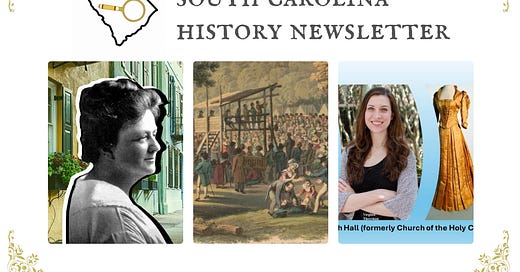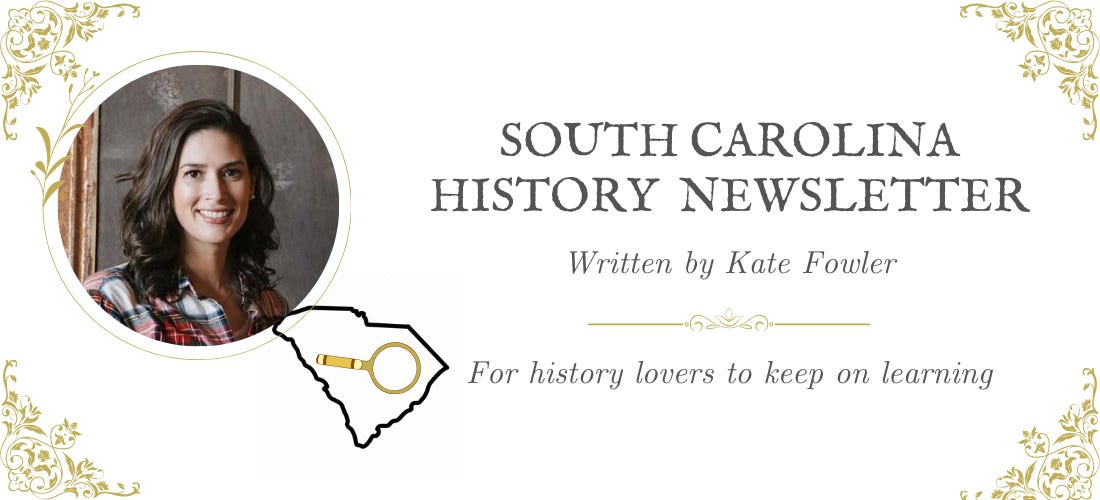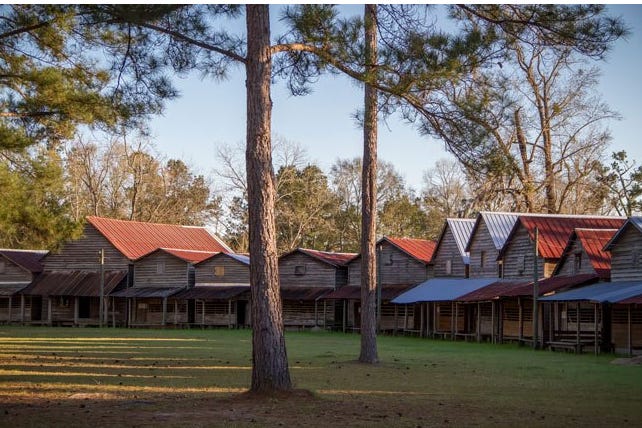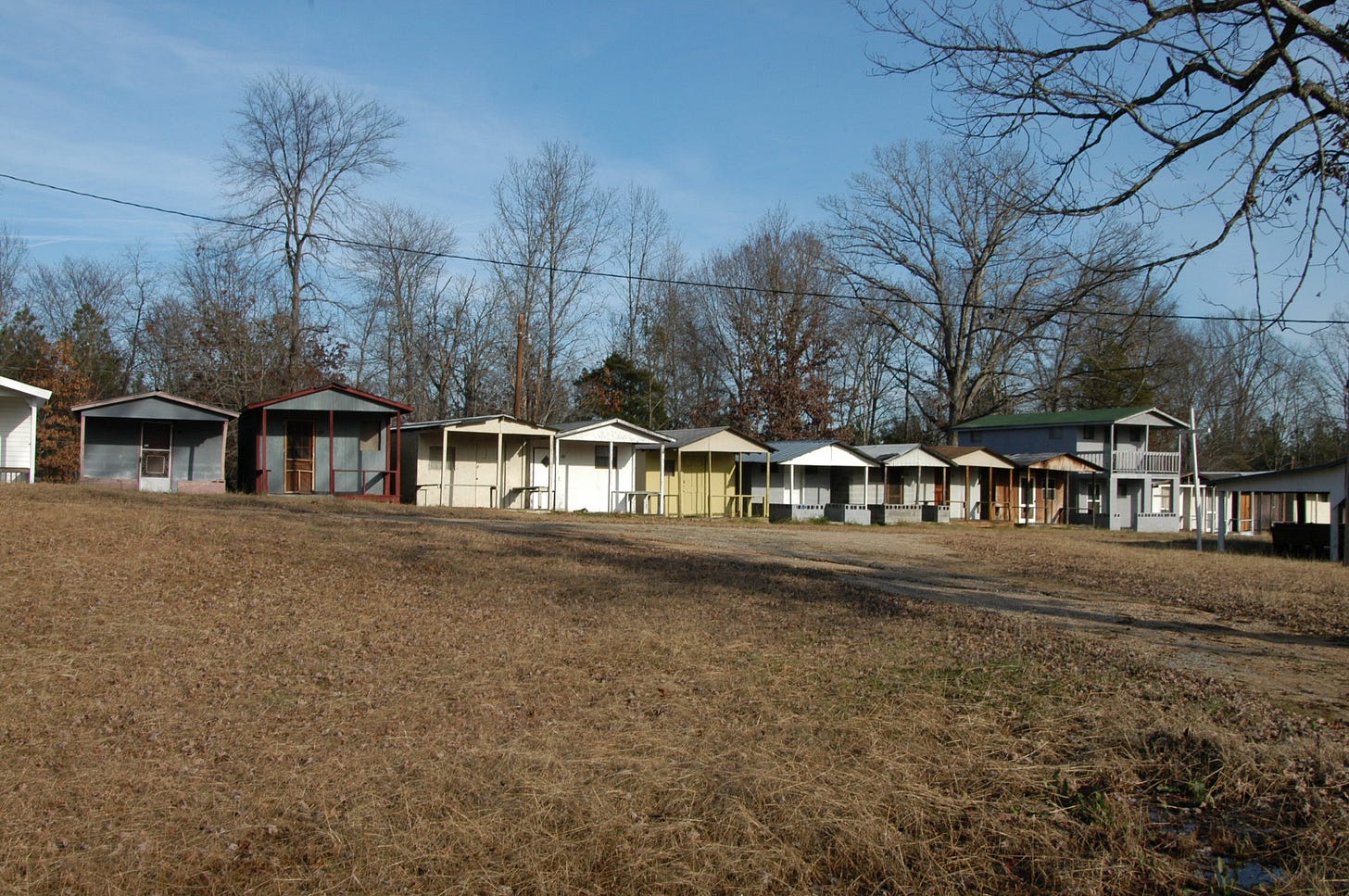#65: Susan Pringle Frost, the 2nd Great Awakening in SC, and a lecture exploring Charleston's fashion history
For South Carolina history lovers far and wide! Enjoy weekly SC history and upcoming SC historical events
Welcome to the first 100 days of the South Carolina History Newsletter! My name is Kate Fowler and I live in Greenville, SC. I have a 9-5 job in marketing, and outside of work, have a deep love of history. I started this newsletter as a passion project to learn more about our beautiful state and build a community of fellow SC history lovers along the way! To establish a foundation for the newsletter and to grow my expertise on a wide variety of South Carolina historical topics, this past February I challenged myself to post 100 newsletters in 100 days. After this coming May 20th, the newsletter will become weekly. Thank you for joining the journey!
Dear reader,
Welcome to Newsletter #65 of The South Carolina History Newsletter! I’m so happy you’re here.
Here’s a little welcome/update audio message:
As always, I’d like to also extend a special welcome to the following new subscribers — woohoo! Thank you for subscribing.
barrystogner
Kdflood68
claudiaellison
susiefcb
I hope you enjoy today’s newsletter, and as always, please feel free to reply to this email with your ideas and suggestions on South Carolina history you’d like to learn more about. I’m only a click away.
Additionally, please join us & keep the conversation going by becoming a member of our SC History Newsletter Facebook Community here! I can’t wait to meet you.
And now, let’s learn some South Carolina history!
Yours truly,
Kate
(Writing from Greenville, SC)
➳ Featured SC History Event
Please enjoy our featured SC History Event below, and click here to visit my SC History Events Calendar that organizes all the upcoming SC history events I have discovered. Please let me know if you’d like to add an event to the calendar! Reply to this email or send me a note at schistorynewsletter@gmail.com.
TODAY, Tuesday, April 16th at 7:00 pm | “Exploring Charleston’s Fashion History” | Church of the Holy Spirit Parish Hall | Daniel Island, SC | FREE Event
“Join the Daniel Island Historical Society as the Charleston Museum's Curator of Historic Textiles Virginia Theerman shares highlights from their nearly 10,000 piece costume and textile collection. Through individual objects worn by both the notable and the unknown in our city’s history, she will speak about the evolution of garments and styles from the Colonial era to the present. Theerman says she's looking forward to her DIHS session. ‘Fashion history is a unique intersection between art, commerce, labor rights, women’s history, and social history. Examining these garments in more detail can reveal much about the lives of the people who wore them and gives us a chance to intimately connect with their place in the historical narrative.’”
➳ SC History Fun Facts
I.
Did you know that when the 2nd Great Awakening swept through South Carolina starting in the 1790s, it led to the creation of large campgrounds where worshippers would meet for large communal “camp meetings”?
Listen to this section in the mini audio voiceover below!
In the years that followed the American Revolution, a religious fervor swept the new American nation.
Baptist, Methodist, and Presbyterian faiths established footholds in communities across the country in a period of time known as the Second Great Awakening from 1790-1845. The First Great Awakening had occurred from 1720-1750.
Methodist and Baptist ministers led the movement in southern states such as Georgia and the Carolinas. These areas remained heavily rural, so ministers would often travel to preach in areas otherwise unserved by a regular minister.
The movement’s most iconic type of event was called “a camp meeting.” These meetings ignored social class and encouraged the “populist belief that through good works and devotion, one could achieve religious freedom.”

The first camp meeting occurred in south-central Kentucky in June 1800, “when a Presbyterian minister and 2 of his colleagues preached for 3 days. On the following day, 2 Methodist ministers arrived and further excited the crowd.”
One year later, an even larger event attracted as many as 20,000 people.
In his autobiography, Methodist circuit rider Peter Cartwright (1785-1872) describes a typical “camp meeting” or “revival”:
"Ten, twenty, and sometimes thirty ministers, of different denominations, would come together and preach night and day, four or five days together; and, indeed, I have known these camp-meetings to last three or four weeks, and great good resulted from them."
These meetings required a large amount of outdoor space with room to fit hundreds—sometimes thousands—of people.
Remnants of these camps can be found across the country, and some are still active.
South Carolina has several 19th century religious campgrounds that exemplify “vernacular architecture and space” associated with these meetings in the south.
Indian Fields Methodist Campground is a great example of one such campground. Located in Dorchester County, it was built in 1848 and remains an active place of worship.

The layout of Indian Fields is based on the biblical story of the Israelites erecting tents, representing the tribes of Israel, encircling a tabernacle. The campground is comprised of nearly 100 rough-hewn cabins, or “tents” as they were first called, built in a 690-foot diameter circle. Inside the circle is a 68 ft x 95 ft open air tabernacle, where ministers would preach and other religious events would occur.
Indian Field’s large complex served vast numbers of people who could not otherwise have fit into a single church or other religious buildings, marking it an important site in America’s 19th century evangelical movement.
Tents at Indian Fields and other campgrounds are “passed down from generation to generation.”
Architecturally, the design of Indian Fields reflects its use as a setting for a collective religious experience. The sense of community is heightened by the circle of adjacent cabins.
Camp Welfare, located in the upper part of South Carolina in Fairfield County on 11 acres of land, is also an active religious campground that serves the black community.
Camp Welfare was founded shortly after the Civil War by the African Methodist Episcopal church and has hosted an annual camp meeting since 1876. Note however that slaves had worshipped at the campsite before the Civil War.
The African Methodist Episcopal Church established the campground soon after the Civil War. Its 100 tents are arranged not in a circle, but in 2 concentric U-shapes. The “arbor,” typically an open-air arena or shelter located in the center of the site, is where communal religious events would take place.
The camp meeting at Camp Welfare was held annually during the last week in August, traditionally “lay-by” time, the final between final cultivation of cotton and corn crops and harvest time.
Both Indian Fields and Camp Welfare highlight the religious fervor of the 2nd Great Awakening and the “popularity of public, communal worship that expanded religious and social boundaries.”
Please scroll to the bottom of this email for my sources for this section
Have you been to Indian Fields Methodist Campground or Camp Welfare? We would love to hear about your experience. Please leave a comment below!
II.
Do you know the name of the person who is responsible for the beautiful colors of Charleston’s Rainbow Row?
Listen to this section in the mini audio voiceover below!
Susan Pringle Frost was born into a prominent Charleston family in 1873. She studied for two years at Saint Mary's Episcopal boarding school in Raleigh, North Carolina and later worked as secretary to architect Bradford Lee Gilbert and a court stenographer for the U.S. District Court in Charleston.
Frost was active in the women's suffrage movement and was first president of the Charleston Equal Suffrage League.
She also was among the early proponents of historic preservation in Charleston, helping to found the Society for the Preservation of Old Dwellings (later the Preservation Society of Charleston) in 1920.
In the early 20th century, Charleston was a city in decline. The city needed concerned citizens like Frost to help bring it back to its former glory.
Betsy Kirkland Cahill, chair of the board of the Preservation Society of Charleston, told the Smithsonian Magazine in 2020:
“There were ills aplenty in the Charleston of the early 20th century. Impoverished by an unrelenting sequence of natural disasters—fire, earthquake, tornado—and ravaged by the Civil War, the city had as many rats as people. Trash was everywhere in the streets, along with dirty water from the butcher pens; there were 12,000 privies on the peninsula, and 434 cows. Streets were unpaved, and in many yards, the only source of water was a single spigot. The beautiful, gracious houses that had characterized the antebellum city were sinking into disrepair and decay…To Sue Frost, the historic homes that were decaying or sometimes literally being dismantled in front of her eyes were the bodies that housed the souls—the soul—of her beloved Charleston.”
Frost’s advocacy helped lead Charleston to adopt the nation's first historic zoning ordinance in 1931 and she fought to preserve many of the city's best known historic properties, including the Joseph Manigault House and the Miles Brewton House.
In addition to her public advocacy, Frost also worked as a real estate agent — buying, holding, rehabilitating, and reselling historic properties — notably along Tradd St., Bedon's Alley, and East Bay.
It was Frost's decision to paint the former mercantile properties along East Bay in non-historic pastel colors that led the area to become known as "Rainbow Row."

Frost was an innovator in the field of historic preservation and her approach of buying and rehabilitating a succession of properties in a single neighborhood anticipated the modern "area" approach to preservation.
Please scroll to the bottom of this email for my sources for this section
➳ Quote from an SC historical figure
“She wanted to revitalize buildings and neighborhoods for the sake of the residents, for all those who would dwell in them. In her conviction, her utter dedication, and her zeal to protect her beautiful city for future generations, Susan Pringle Frost set the Preservation Society on the course it has followed for the past century.”
— Betsy Kirkland Cahill, chair of the board of the Preservation Society of Charleston, in a quote for the Smithsonian Magazine in 2020
Camp Meetings article sources:
Fitzpatrick, Bill. “South Carolina’s Religious Campgrounds | National Trust for Historic Preservation.” National Trust for Historic Preservation, https://savingplaces.org/stories/south-carolina-religious-campgrounds. Accessed 14 Apr. 2024.
“Indian Field Campground - SC Picture Project.” SC Picture Project, 18 Sept. 2013, https://www.scpictureproject.org/dorchester-county/indian-field-campground.html. Accessed 14 Apr. 2024.
“Camp Welfare.” Historical Marker Database, 22 August 2022, https://www.hmdb.org/m.asp?m=14613. Accessed 14 Apr. 2024.
Susan Pringle Frost article sources:
Bland, Sidney R. “Frost, Susan Pringle | South Carolina Encyclopedia.” South Carolina Encyclopedia, https://www.scencyclopedia.org/sce/entries/frost-susan-pringle/. Accessed 15 Apr. 2024.
Billock, Jennifer. “The Suffragist With a Passion for Saving Charleston’s Historic Architecture.” Smithsonian Magazine, Smithsonian Magazine, 23 Mar. 2020, https://www.smithsonianmag.com/travel/suffragette-with-passion-for-saving-charlestons-historic-architecture-180974421/. Accessed 15 Apr. 2024.
I always want to improve my work. Answer the poll below to give me your review of today’s newsletter. I also welcome your suggestions for new content! Simply reply to this email with your ideas. Thank you!















